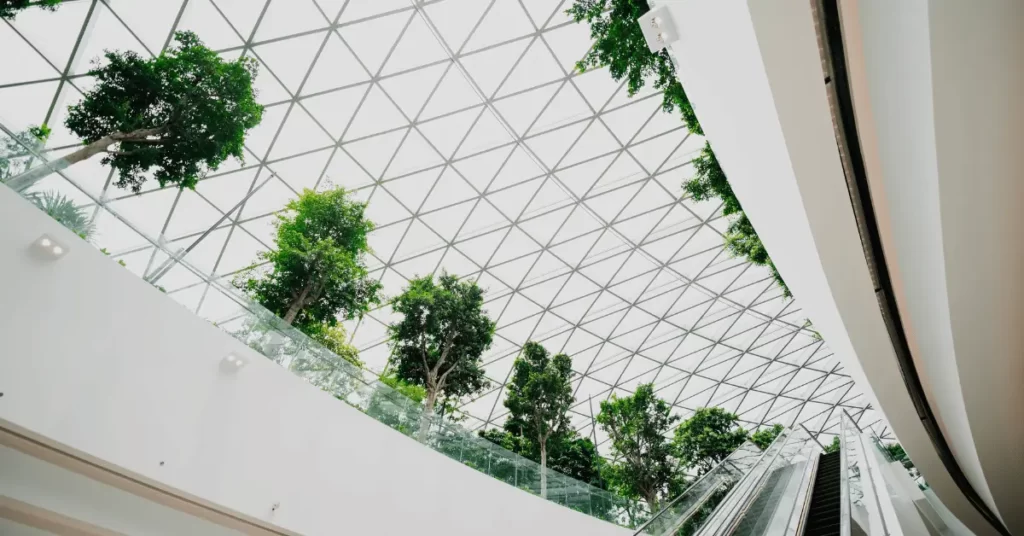Sustainable Architecture: Building for a Greener Future
Sustainable architecture is an essential part of creating a greener future. Buildings account for a significant amount of the world’s energy consumption and greenhouse gas emissions. Sustainable architecture seeks to reduce the environmental impact of buildings by promoting energy efficiency, using sustainable materials, and designing buildings that work in harmony with their surroundings. In this blog post, we’ll explore the principles of sustainable architecture, the benefits of green buildings, and the latest trends in sustainable design.

Principles of Sustainable Architecture
Sustainable architecture is guided by several key principles. These include:
- Energy Efficiency:
Sustainable buildings are designed to minimize energy consumption by using passive design strategies such as natural ventilation, shading, and insulation. They also incorporate energy-efficient technologies such as LED lighting and smart controls to further reduce energy use. - Use of Sustainable Materials:
Sustainable architecture promotes the use of materials that have a low environmental impact, such as recycled or reclaimed materials, locally sourced materials, and materials that are non-toxic and biodegradable. - Water Conservation:
Sustainable buildings are designed to conserve water by incorporating features such as low-flow fixtures, rainwater harvesting systems, and greywater recycling systems. - Design for Adaptability:
Sustainable buildings are designed to be adaptable to changing needs over time. This means that they are flexible and can be easily modified or repurposed as needed.
Benefits of Green Buildings
Green buildings offer numerous benefits, both for the environment and for building occupants. Some of the key benefits of sustainable architecture include:
- Reduced Environmental Impact:
Green buildings have a lower environmental impact than traditional buildings, as they use less energy and resources and produce fewer greenhouse gas emissions. - Lower Operating Costs:
Sustainable buildings are designed to be more energy-efficient, which can result in significant cost savings over time. Additionally, features such as water conservation systems can help to reduce water bills. - Improved Indoor Air Quality:
Sustainable buildings are designed to promote healthy indoor environments by using non-toxic materials and providing adequate ventilation. This can lead to improved health and productivity for building occupants. - Increased Resilience:
Sustainable buildings are designed to be resilient to the impacts of climate change, such as extreme weather events and rising sea levels. This can help to protect building occupants and assets from damage and disruption.
Trends in Sustainable Architecture
The field of sustainable architecture is constantly evolving, with new trends and innovations emerging all the time. Some of the latest trends in sustainable architecture include:
- Net-Zero Energy Buildings:
Net-zero energy buildings are designed to produce as much energy as they consume, typically through the use of renewable energy sources such as solar or wind power. - Biophilic Design:
Biophilic design seeks to connect building occupants with nature by incorporating natural elements such as plants, water features, and natural light into building design. - Passive House Design:
Passive house design is a rigorous standard for energy-efficient buildings that involves minimizing energy consumption through passive design strategies such as insulation, air sealing, and ventilation. - Circular Design:
Circular design seeks to create buildings that are designed for disassembly and reuse at the end of their life cycle. This can help to reduce waste and promote a more circular economy.
Conclusion
Sustainable architecture is an essential part of creating a greener future. By promoting energy efficiency, using sustainable materials, and designing buildings that work in harmony with their surroundings, we can reduce the environmental impact of buildings and create healthier, more resilient spaces for people to live and work in.
Green buildings offer numerous benefits, from reduced operating costs to improved indoor air quality, and the latest trends in sustainable architecture are pushing the boundaries of what is possible. As we look to the future, it is clear that sustainable architecture will continue to play a crucial role in shaping the built environment and promoting environmental sustainability.
In conclusion, sustainable architecture is an important tool for creating a greener future. By incorporating sustainable design principles, using energy-efficient technologies, and promoting the use of sustainable materials, architects and designers can create buildings that are both environmentally responsible and beneficial for building occupants. As the field of sustainable architecture continues to evolve, we can expect to see more innovative solutions and approaches emerge, helping us to build a more sustainable and resilient world.
For more SketchUp tutorials you can check out https://www.sketchupguru.com/blog/
You can also check more tutorial videos for sketchup on our YouTube Channel,
https://www.youtube.com/c/SketchupGuru
To know about the Top Online 3D Rendering Courses for 2022 click,










